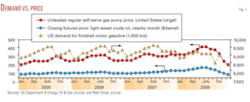Driving habits transformed
A recent Gallup poll entitled “Despite Cheaper Gas, New Driving Habits Sticking” caught this editor’s eye.
In this poll, Gallup found that 64% of Americans reported changing their driving habits drastically due to higher gasoline prices during mid-2008. After returning to survey those drivers again after gasoline prices plummeted late last year, the pollsters found that a mere 12% had slipped back to their old driving routines.
Not surprisingly, in this mid-December 2008 survey, Gallup found that it was mostly upper-income Americans who did not change their driving habits and routines as a result of the rise in prices. Their disposable income was not directly affected by last summer’s high pump prices. Instead, it was drivers from households with an annual income of less than $75,000 who were more likely to respond to the higher prices by taking a different approach to transportation.
Gallup noted, “As pump prices plunged, it should not be surprising that 19% of lower-income Americans say they have returned to their old driving habits, compared with 11% of middle-income and 8% of upper-income Americans.”
Age also played a role in the survey results, as 61% of Americans aged 18-34 and 62% of Americans aged 55 and older said that they changed their driving habits, driving less due to higher prices.
But those aged 35-54 were the most likely to change their routines due to rising prices, with two-thirds saying that high gasoline prices were a deterrent. This is not unexpected, because those in the 35-54 age group are doing most of the driving by commuting to work and chauffeuring children to after-school activities.
Almost 20% of younger Americans said they would revert to their old driving habits once pump prices fell, compared with 12% for ages 35-54 and only 6% of those 55 years and older.
Comparing data
OGJ’s weekly and monthly statistics will support the surveys’ findings. In the graph below, note that when prices reached a certain level, motor gasoline demand started to decline. Motor gasoline demand primarily fell in mid-2008, once gasoline hit unprecedented prices of $3-4/gal.
Motor gasoline consumption typically follows a cyclical trend, rising and falling at certain times of the year. The graph indicates this cycle. Demand goes up slightly in the months of the summer driving season and begins to decline in September.
Even though demand rose from the beginning of last year to hit the highest point in May 2008—the start of driving season—at 9.216 million b/d, motor gasoline consumption began to slip, and consumers started to watch their driving habits during the summer months, as compared with the previous year and the same time period.

